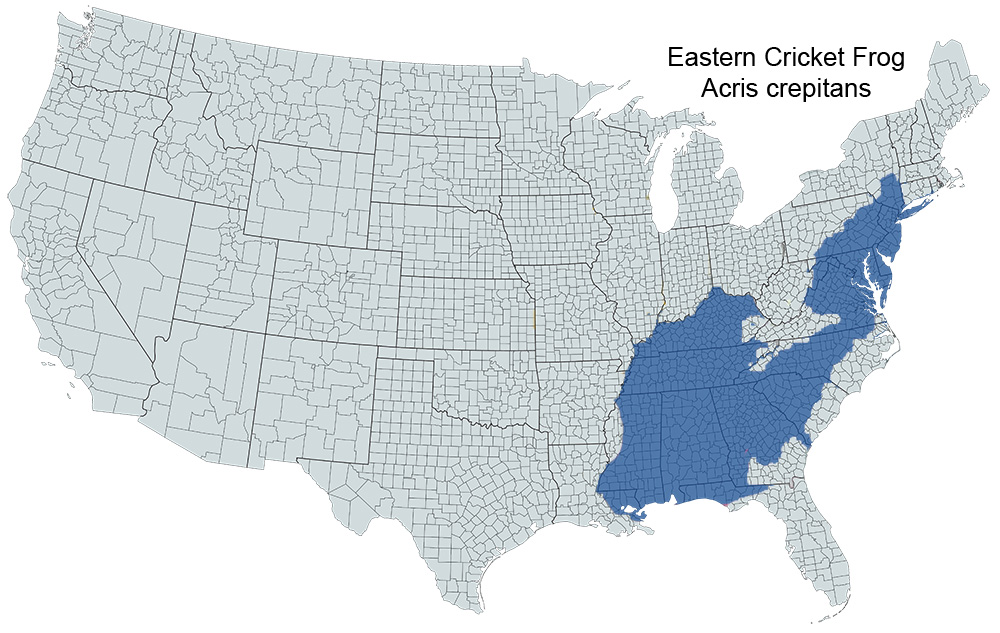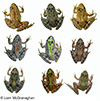Eastern Cricket Frog
Acris crepitans
Common Name: |
Eastern Cricket Frog |
Scientific Name: |
Acris crepitans |
Etymology: |
|
Genus: |
Acris is derived from the Greek words acr which means "sharp" and is meaning "equal". |
Species: |
crepitan is derived from the Latin word crepit which means "rattle" and ans which means "a handle" this refers to the "hand rattle" like call of the frog. |
Subspecies: |
|
Average Length: |
1.6 - 3.5 cm |
Virginia Record Length: |
|
Record length: |
Physical Description - This is a small frog reaching lengths of 5/8 to 1-3/8 inches (16-35 mm). This species has moist warty skin, a dark triangle shape between the eyes and a median stripe or Y-figure on its back. This figure may be bright green, russet, yellow, or shades of brown or gray. On average, this species has a short hind leg. Therefore, when extended, the heel of the hind leg does not reach the snout. This species can be distinguish from Acris gryllus using the following characteristics: the dark stripe on the back of the thigh is generally more ragged/less defined than in A. gryllus and in A.c. crepitans, the first toe is completely webbed and the first 1-1/2 to 2 joints of the longest toe are free. Tadpoles have a distinctive black tail tip.
Reproduction - Breeding season for this species lasts from March to July. A study of a temporary pond in Texas found that the breeding period for this species was April to June. The male mating call resembles the sound of two stones being hit together. A single call usually lasts through 20-30 beats. Breeding occurs during warm weather in shallow waters. The female lays eggs singly or in small groups. The eggs are attached to plant stems or scattered on the water body substrate. Tadpoles have a distinctive black tail tip. Metamorphosis occurs during late summer. The newly transformed frog is typically about 14 mm long. First reproduction occurs when individuals are less than 1 year old.
Altig & McDiarmid 2015 - Classification and Description:
- Eastern Clump
- Arrangement 1 - Eggs oviposited as small clumps, not well
formed, surface irregular and not distinctly lobate, eggs often fall apart as
singles soon after oviposition.
- Sub-arrangement A - Eggs deposited in permanent, nonflowing water; Ovum Diameter 0.9-1.2 mm; Egg Diameter 23-3.1 mm; 2 jelly layers; clutch about 300.
- Arrangement 1 - Eggs oviposited as small clumps, not well
formed, surface irregular and not distinctly lobate, eggs often fall apart as
singles soon after oviposition.
Tadpoles: Lateral eyes; spiracular tube short and on left side; dorsum medium brown with some faint mottling; darker mottling ventrolaterally; tail muscles sometimes banded; tail tip usually black; large hind legs; toes webbed about 75% of toe length; up to 36.0 mm in total length at Gosner stage 36.
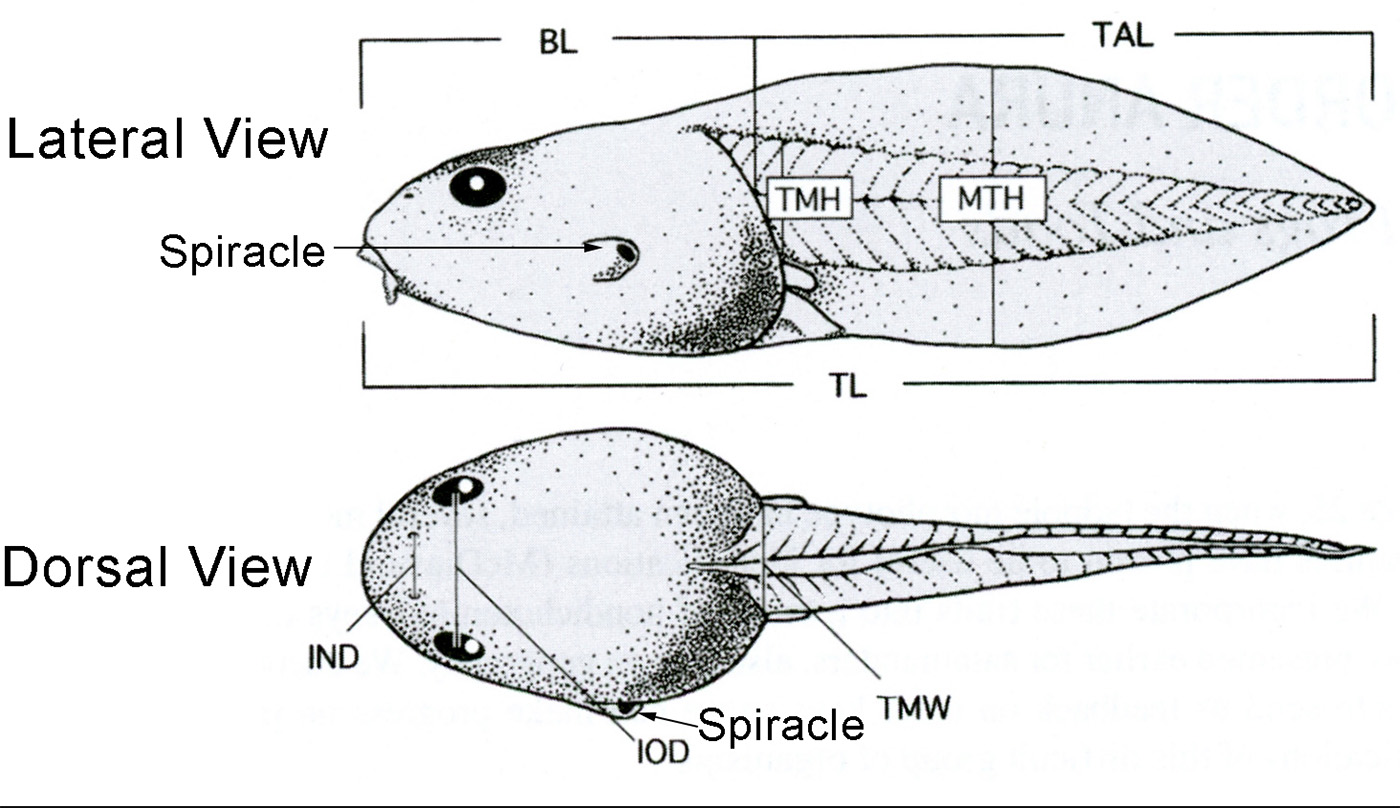
| Lateral View | Dorsal View |
|---|---|
| BL = Body Length | IND = Internarial Distance |
| MTH = Maximum Tail Height | IOD = Interorbital Distance |
| TAL = Tail Length | TMW = Tail Muscle Width |
| TL = Total Length | |
| TMH = Tail Muscle Height |
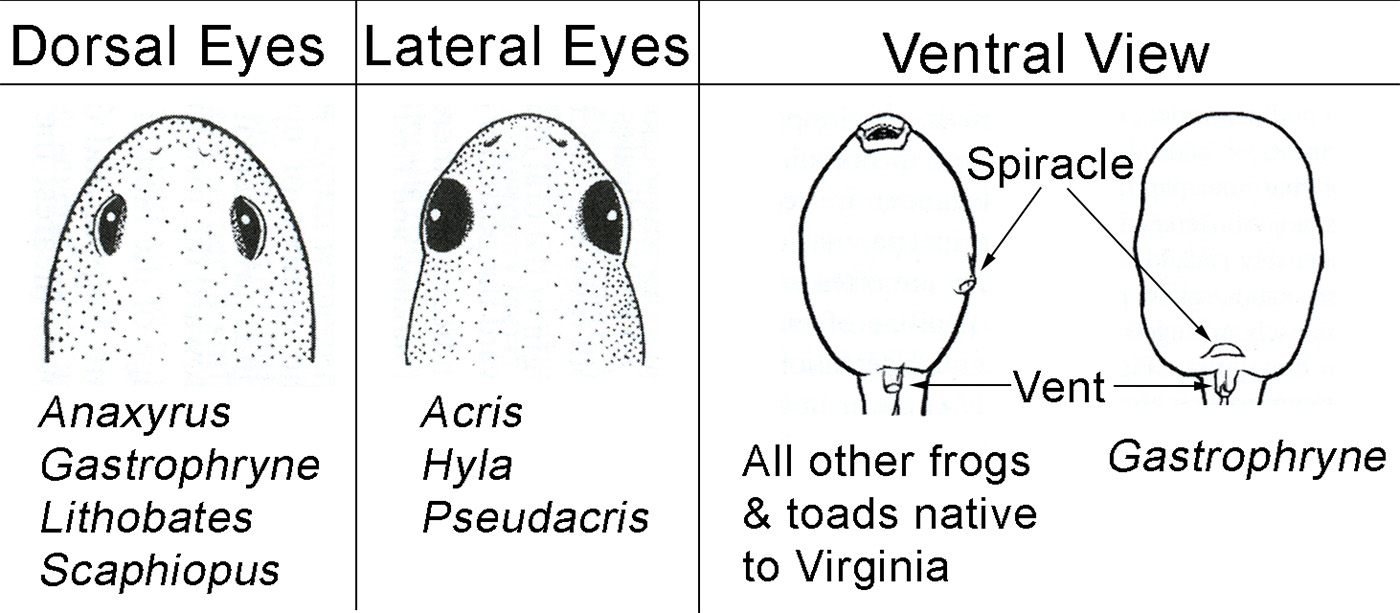
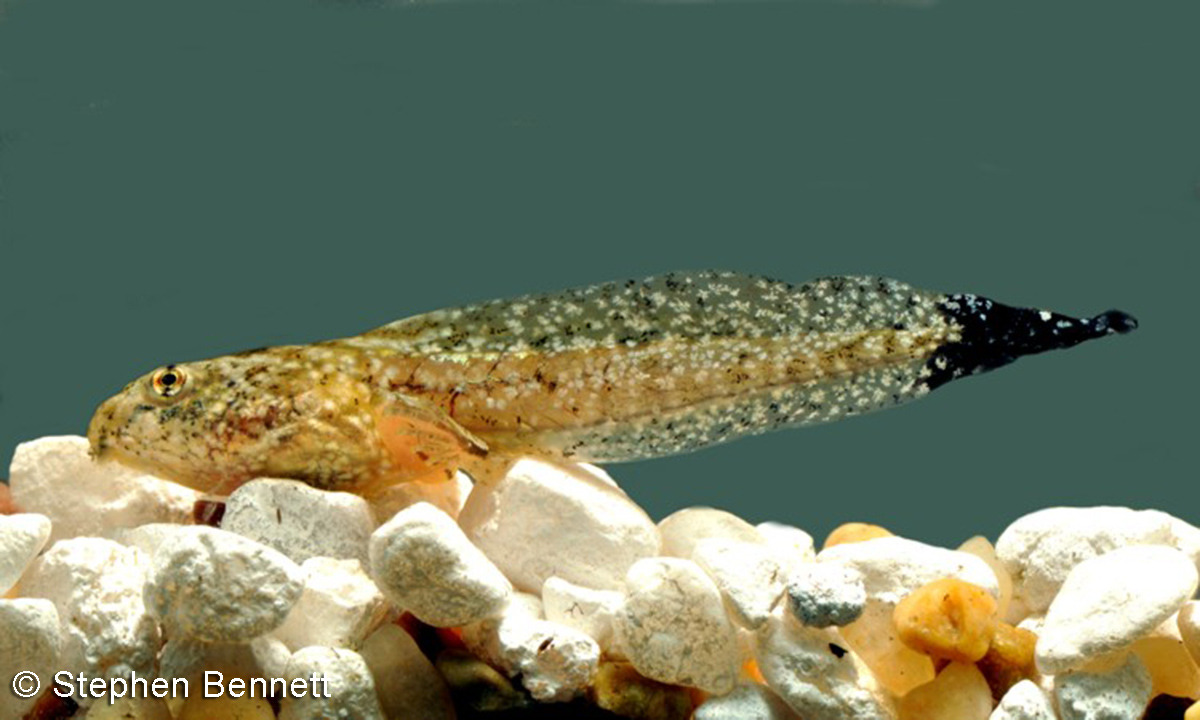
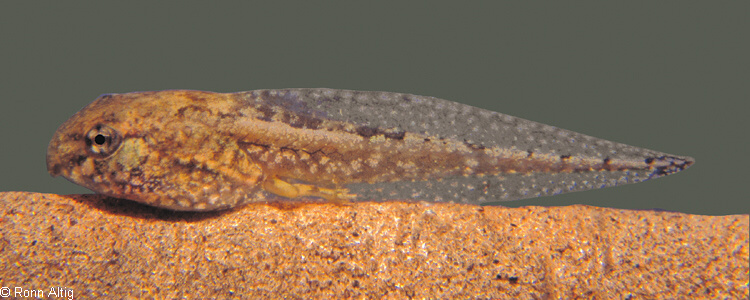
Behavior - This species has been shown to move 15 to 100 meters daily along the margin of a pond. A study of A. crepitans in Indiana found that the abundance of prey items in the stomachs of specimens was correlated with relative abundance of prey items in the surrounding habitat. This species is an opportunistic predator consuming primarily small arthropods. This species prefers grassy margins of ponds, ditches and wetlands. Permanent bodies of water with emergent or shoreline vegetation and exposure to the sun are preferred habitat. Though this species can also be found near intermittent streams.
Origin - Native
Limiting Factors - This species prefers open grassy areas along ponds, ditches and marshes and breeds in shallow water.
Aquatic/Terrestrial Associations - This species is largely a Piedmont species. It enters river valleys and sandhills of the coastal plain and is localized in major valleys in the mountains. This species is found in the grassy margins of ponds, ditches and wetland areas.
References for Life History
- Conant, Roger and, Collins, John T., 1998, Peterson Field Guide: Reptiles and Amphibians, Eastern/Central North America, 616 pgs., Houghton Mifflin Company;, Boston
- Duellman, William E. and, Trueb, Linda, 1986, Biology of Amphibians, 671 pgs., The Johns Hopkins University Press, Baltimore
- Mitchell, Joseph C. and Karen K. Reay, 1999, Atlas of Amphibians and Reptiles in Virginia, Num. 1, 122 pgs., Virginia Department of Game and Inland Fisheries, Richmond, VA
- Martof, B.S., Palmer, W.M., Bailey, J.R., Harrison, III J.R., 1980, Amphibians and Reptiles of the Carolinas and Virginia, 264 pgs., UNC Press, Chapel Hill, NC
- Wilson, L.A., 1995, Land manager's guide to the amphibians and reptiles of the South, 360 pp. pgs., The Nature Conservancy, Southeastern Region, Chapel Hill, NC
Photos:
*Click on a thumbnail for a larger version.
Verified County/City Occurrence
Accomack
Albemarle
Alleghany
Amelia
Amherst
Appomattox
Augusta
Bath
Bedford
Botetourt
Brunswick
Buckingham
Campbell
Caroline
Charles City
Charlotte
Chesterfield
Craig
Culpeper
Cumberland
Dinwiddie
Essex
Fairfax
Fauquier
Fluvanna
Franklin
Frederick
Gloucester
Goochland
Greene
Greensville
Halifax
Hanover
Henrico
Henry
James City
King and Queen
King George
King William
Lancaster
Loudoun
Louisa
Lunenburg
Madison
Mathews
Mecklenburg
Middlesex
Montgomery
Nelson
New Kent
Northampton
Northumberland
Nottoway
Orange
Page
Patrick
Pittsylvania
Powhatan
Prince Edward
Prince George
Prince William
Rappahannock
Richmond
Rockbridge
Rockingham
Southampton
Spotsylvania
Stafford
Surry
Sussex
Warren
Westmoreland
York
CITIES
Alexandria
Charlottesville
Fredericksburg
Lynchburg
Newport News
Petersburg
Suffolk
Williamsburg
Winchester
Verified in 73 counties and 9 cities.
U.S. Range
